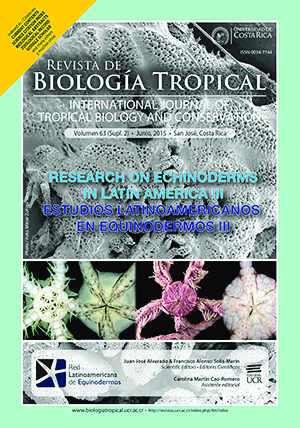Resumen
El ciclo gametogénico y el índice gonadosomático (IG) del erizo negro Echinometra lucunter fue examinado entre junio de 2010 y noviembre de 2011 en el noreste de Venezuela (Isla de Lobos, Península de Araya y Ensenada de Turpialito, Golfo de Cariaco). Las gónadas están integradas por extensos acinos ramificados, recubiertos por tejido conectivo, seguido de una capa delgada de células que se diferencian en fagocitos nutritivos y gametos, los cuales cambian en sus proporciones y tamaños con los estadios de maduración. Generalmente, en ambas localidades se presentaron varios estadios de maduración, con desoves simultáneos. En Isla Lobos predominaron los individuos en estado de reserva con un corto período de madurez sexual, mientras que en la Ensenada de Turpialito predominaron organismos maduros y desovados. El IG sugiere que los desoves están asociados a las precipitaciones estacionales de la región; mostrando una estrategia reproductiva conservadora, acumulando reservas energéticas en el periodo de mayor producción primaria asociada a los periodos de surgencia costera, cuando la energía de los fagocitos nutritivos es transferida a los gametos hasta su maduración y expulsión al medio ambiente. Las características biológicas y reproductivas de los organismos en Turpialito mostraron elevados IG y mayor tejido gonadal para consumo comercial.
Citas
Alsaffar, A., & Khalid, P. (2000). Reproductive cycles of Diadema setosum and Echinometra mathaei (Echinoidea: Echinodermata) from Kuwait (Northern Arabian Gulf). Bulletin of Marine Science, 67, 845-856.
Astudillo, D., J. Rosas, A. Velásquez, T. Cabrera & C. Maneiro. 2005. Crecimiento y supervivencia de larvas de Echinometra lucunter (Echinoidea: Echinometridae) alimentadas con las microalgas Chaetoceros gracilis e Isochrysis galbana. Rev. Biol. Trop. 53 (Supl. 3): 377-344.
Cameron, R. 1986. Reproduction larval occurrence and recruitment in Caribbean sea urchins. Bull. Mar. Sci. 39: 332-346.
Cruz-Motta, J. (2007). Análisis espacial de las comunidades tropicales intermareales asociadas a los litorales rocosos de Venezuela. Ciencias Marinas, 33, 133-148.
Espinoza, R., Reyes, J., Himmelman, J., & Lodeiros, C. (2008). Actividad reproductiva de los erizos Lytechinus variegatus y Echinometra lucunter (Echinodermata: Echinoidea) en relación con factores ambientales en el Golfo de Cariaco, Venezuela. Revista de Biología Tropical, 56(Suppl. 3), 341-350.
Hendler, G., Miller, J., Pawson, D., & Porter, K. (1995). Sea Stars, Sea Urchins, and Allies. Echinoderms of Florida and the Caribbean. Washington: Smithsonian Institution Press.
Johnson, R., & Wichern, D. (1992). Applied multivariate statistical analysis. New York: Prentice-Hall:
Lawrence, J. (2007). Edible sea urchins: use and life-history strategies. In J. M. Lawrence (Ed.), Edible Sea Urchins: Biology and Ecology (pp. 1-9). Amsterdam: Elsevier.
Lessios, H. A. (1981). Reproductive periodicity of the echinoids Diadema and Echinometra on the two coasts of Panama. Journal of Experimental Marine Biology and Ecology, 50, 47-61.
Lessios, H. A. (1991). Presence and absence of monthly reproductive rhythms among eight Caribbean echinoids off the Coast of Panama. Journal of Experimental Marine Biology and Ecology, 153, 27-47.
Lewis J., & Storey, G. (1984). Differences in morphology and life history traits of the echinoid Echinometra lucunter from different habitats. Marine Ecology Progress Series, 15, 207-211.
Lima E., Gomes, P., & Souza, J. (2009). Reproductive biology of Echinometra lucunter (Echinodermata: Echinoidea) in a northeast Brazilian sandstone reef. Anais da Academia Brasileira de Ciências, 81, 51-59.
Lovatelli, A., & Sarkis, S. (Eds.). (2011). A regional shellfish hatchery for the Wider Caribbean: Assessing its feasibility and sustainability. Roma: FAO.
Lodeiros, C., Martín, A., Francisco, V., Noriega, N., Díaz, Y., Reyes, J., & Alió, J. (2013). Echinoderm from Venezuela: Scientific recount, diversity and distribution. In J. J. Alvarado, & F. A. Solis-Marin (Eds.), Echinoderm Research and Diversity in Latin America (pp. 235-275). Berlin: Springer.
Mahdavi, N., Haghighat, Z., Karamzadeh, S., Naseri, F., Esteki. A, & Rameshi, H. (2008). Reproductive cicle of the sea urchin Echinometra mathaei (Echinodermatidea) in the Persina Gulf, Iran. Journal of Biological Science, 8, 1138-1148.
Mariante F., Lemos, G., Eutrópio, F., & Gomes, L. (2009). Biología reprodutiva de Echinometra lucunter (Echinodermata: Echinoidea) na Praia da Costa, Vila Velha, Espírito Santo. Zoología, 26, 641-646.
Martínez, A. (1986). Equinodermos de la Isla de Aves, Venezuela. Boletin del Instituto Oceanográfico de la Universidad de Oriente, 25, 195-213.
Martínez-Pita, I., García, F., & Pita, M. (2010). The effect of seasonality on gonad fatty acids of sea urchins Paracentrotus lividus and Arbacia lixula (Echinodermata: Echinoidea). Journal of Shellfish Research, 29, 517-525.
McPherson, B. (1969). Studies of the biology of the tropical sea urchins Echinometra lucunter and Echinometra viridis (Echinoidea) in Bostaneh, Persian Gulf, Iran. Bulletin of Marine Science, 19, 194-213.
Montealegre, S. & Gómez, A. (2005). Ciclo reproductivo de Lytechinus variegatus (Echinoidea: Toxopneustidae) en el sur de Isla Margarita, Venezuela. Revista de Biología Tropical, 53(Supl. 3), 305-312.
Pearse, J., & Cameron, R. (1991). Echinodermata: Echinoidea. In A. C. Giese, J. S. Pearse, & V. B. Pearse, (Eds.), Reproduction of Marine Invertebrates, Vol. VI, Echinoderms and Lophophorates (pp. 513-622). Pacific Grove: Boxwood Press.
Walker, C., Tatsuya, U., & Lesser, M. (2007). Gametogenesis and reproduction of sea urchins. In J. M. Lawrence (Ed.), Edible Sea Urchins: Biology and Ecology (pp. 11-33). Amsterdam: Elsevier.
Zar, J. (2010). Biostatistical Analysis. USA: Pearson Education.
Zoppi, E. (1967). Contribución al estudio de los equinodermos de Venezuela. Acta Biologica de Venezuela, 5, 267-283.
##plugins.facebook.comentarios##

Esta obra está bajo una licencia internacional Creative Commons Atribución 4.0.
Derechos de autor 2015 Revista de Biología Tropical






